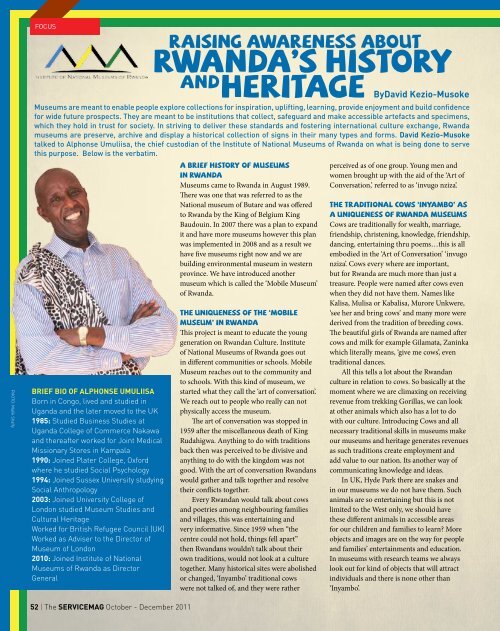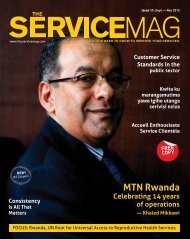Province d - The Service Mag
Province d - The Service Mag
Province d - The Service Mag
You also want an ePaper? Increase the reach of your titles
YUMPU automatically turns print PDFs into web optimized ePapers that Google loves.
PHOTO: Malik Shaffy<br />
FOCUS<br />
52 | <strong>The</strong> SERVICEMAG October - December 2011<br />
Raising awareness about<br />
Rwanda’s history<br />
and heritage<br />
ByDavid Kezio-Musoke<br />
Museums are meant to enable people explore collections for inspiration, uplifting, learning, provide enjoyment and build confidence<br />
for wide future prospects. <strong>The</strong>y are meant to be institutions that collect, safeguard and make accessible artefacts and specimens,<br />
which they hold in trust for society. In striving to deliver these standards and fostering international culture exchange, Rwanda<br />
museums are preserve, archive and display a historical collection of signs in their many types and forms. David Kezio-Musoke<br />
talked to Alphonse Umuliisa, the chief custodian of the Institute of National Museums of Rwanda on what is being done to serve<br />
this purpose. Below is the verbatim.<br />
A brief history of museums<br />
in Rwanda<br />
Museums came to Rwanda in August 1989.<br />
<strong>The</strong>re was one that was referred to as the<br />
National museum of Butare and was offered<br />
to Rwanda by the King of Belgium King<br />
Baudouin. In 2007 there was a plan to expand<br />
it and have more museums however this plan<br />
was implemented in 2008 and as a result we<br />
have five museums right now and we are<br />
building environmental museum in western<br />
province. We have introduced another<br />
museum which is called the ‘Mobile Museum’<br />
of Rwanda.<br />
<strong>The</strong> uniqueness of the ‘Mobile<br />
Museum’ in Rwanda<br />
This project is meant to educate the young<br />
generation on Rwandan Culture. Institute<br />
of National Museums of Rwanda goes out<br />
in different communities or schools. Mobile<br />
Museum reaches out to the community and<br />
to schools. With this kind of museum, we<br />
started what they call the ‘art of conversation’.<br />
We reach out to people who really can not<br />
physically access the museum.<br />
<strong>The</strong> art of conversation was stopped in<br />
1959 after the miscellaneous death of King<br />
Rudahigwa. Anything to do with traditions<br />
back then was perceived to be divisive and<br />
anything to do with the kingdom was not<br />
good. With the art of conversation Rwandans<br />
would gather and talk together and resolve<br />
their conflicts together.<br />
Every Rwandan would talk about cows<br />
and poetries among neighbouring families<br />
and villages, this was entertaining and<br />
very informative. Since 1959 when “the<br />
centre could not hold, things fell apart”<br />
then Rwandans wouldn’t talk about their<br />
own traditions, would not look at a culture<br />
together. Many historical sites were abolished<br />
or changed, ‘Inyambo’ traditional cows<br />
were not talked of, and they were rather<br />
perceived as of one group. Young men and<br />
women brought up with the aid of the ‘Art of<br />
Conversation,’ referred to as ‘invugo nziza’.<br />
<strong>The</strong> traditional cows ‘Inyambo’ as<br />
a uniqueness of Rwanda museums<br />
Cows are traditionally for wealth, marriage,<br />
friendship, christening, knowledge, friendship,<br />
dancing, entertaining thru poems…this is all<br />
embodied in the ‘Art of Conversation’ ‘invugo<br />
nziza’. Cows every where are important,<br />
but for Rwanda are much more than just a<br />
treasure. People were named after cows even<br />
when they did not have them. Names like<br />
Kalisa, Mulisa or Kabalisa, Murore Unkwere,<br />
‘see her and bring cows’ and many more were<br />
derived from the tradition of breeding cows.<br />
<strong>The</strong> beautiful girls of Rwanda are named after<br />
cows and milk for example Gilamata, Zaninka<br />
which literally means, ‘give me cows’, even<br />
traditional dances.<br />
All this tells a lot about the Rwandan<br />
culture in relation to cows. So basically at the<br />
moment where we are climaxing on receiving<br />
revenue from trekking Gorillas, we can look<br />
at other animals which also has a lot to do<br />
with our culture. Introducing Cows and all<br />
necessary traditional skills in museums make<br />
our museums and heritage generates revenues<br />
as such traditions create employment and<br />
add value to our nation. Its another way of<br />
communicating knowledge and ideas.<br />
In UK, Hyde Park there are snakes and<br />
in our museums we do not have them. Such<br />
animals are so entertaining but this is not<br />
limited to the West only, we should have<br />
these different animals in accessible areas<br />
for our children and families to learn? More<br />
objects and images are on the way for people<br />
and families’ entertainments and education.<br />
In museums with research teams we always<br />
look out for kind of objects that will attract<br />
individuals and there is none other than<br />
‘Inyambo’.



